Portraits in Gardening: Michael and Kathi Rock's Hummingbird Journey
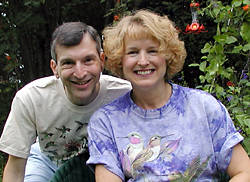
For newlyweds, marriage is a new world and a journey filled with surprises. When Kathi and Michael Rock wed in the late 1990s, the gift of a hummingbird feeder quickly led them into a life dedicated to wildlife gardening.
Kathi Rock says that by her early 40s when they wed, she had never seen a hummingbird in real life. However, Michael Rock had seen them at his parents' home in Oklahoma and on a trumpet vine (Lonicera sempervirens) at his former Tennessee home.
His fascination with the tiny birds caused the couple to add a hummingbird feeder to their wedding registry wish list. It was a fortuitous request that led the Rocks into the world of nectar-rich Salvias and other favorite hummingbird flowers.
Being Mesmerized by Flying Jewels
If you've ever felt the rapid buzz of hummingbird wings passing by, watched them dart amongst flowers collecting nectar or admired the glint of sunlight on their colorful wings, you know what it is like to fall in love with these tiny creatures often referred to as "flying jewels."
Consider the impact of viewing a glittering swarm up close. That's what happened when the newlyweds visited a lakeside home in northern Wisconsin where numerous hummingbird feeders were causing a hummingbird mob scene. The Rocks had just recently moved to Madison in the southern part of the state.
"We were absolutely mesmerized," Kathi Rock says. But she recalls that what really captured their hearts was a visit by two hummingbirds later that summer at their own feeder. It was a small dinner party, but momentous.
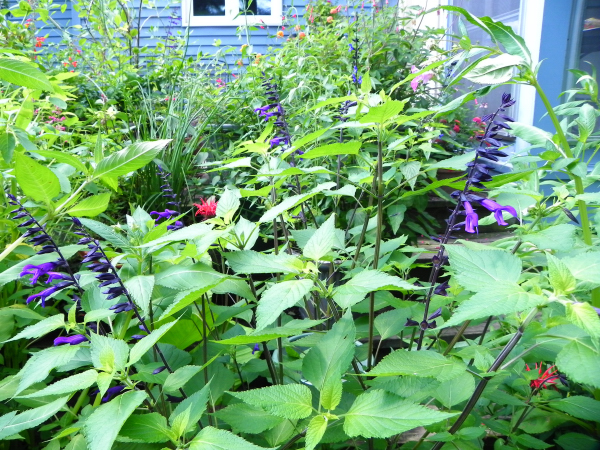
Photo courtesy of the Rock's.
The Rocks soon discovered there was little on the menu for hummingbirds in their yard. Kathi Rock says flowers were almost totally absent.
So they began studying hummingbirds in many ways. Their education included:
- Joining online listserves and forums
- Participating in organizations such as the Hummingbird Society and the Hummer/Bird Study Group led by the late Bob Sargent and his wife, Martha (click here for a video of Sargent demonstrating hummingbird release)
- Traveling around the nation for birding events and
- Searching for the best hummingbird plants, in part, by visiting botanic gardens.
Similar to hummingbirds searching for food, the Rocks flew great distances to gather information in Arizona, California, Colorado, Georgia, Louisiana, Missouri, South Carolina and Texas.
Along the way, they observed a wide array of hummingbird species and became acquainted with many experts, including hummingbird banders -- volunteers who are trained to capture hummingbirds gently and apply miniscule ID bands to their legs. The bands help scientists track migration patterns.
Gradually, the Rocks transformed their landscape into a hummingbird haven.
Planting Blooms, Not Grass
Grass doesn't dominate the landscape at the Rock's home. Instead, it forms pathways through large, sunny flowerbeds massed with lots of nectar-rich Salvias and companion plants.
When they moved there in 1998, Kathi Rock says, their urban home had few plantings that appealed to hummingbirds. This meant replanting shrubs and replacing lots of grass with flowering plants attractive to hummers. It also required removal of some trees to increase sunny planting areas.
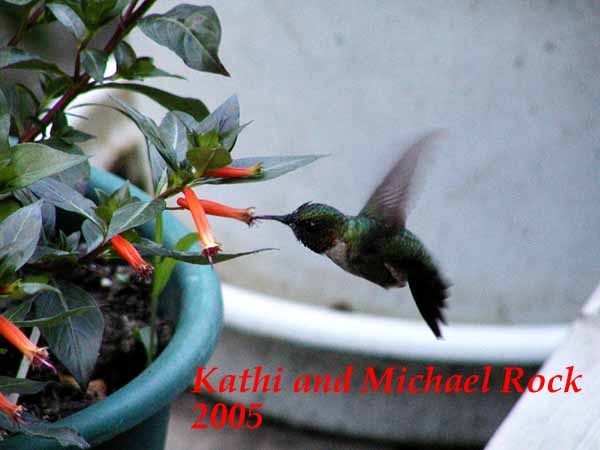
Photo courtesy of the Rock's.
Nowadays, she says, they supplement their in-ground plantings with containers filled with hummingbird favorites such as Agastaches that "don't care for our heavy, fertile soil."
Madison is in USDA Cold Hardiness Zone 5a, which can drop to -20 degrees F in winter. Many Salvias that the Rocks plant as annuals would be herbaceous perennials or shrubs elsewhere. Kathy Rock notes that "reestablishing the garden each spring is a huge amount of work and expense."
Consequently, they are experimenting with overwintering techniques, such as bringing some plants indoors for the winter and, at the onset of cold weather, layering others with bags of leaves covered with tarps. (For information about protecting Salvias in winter please read Quick Digs: Prepping and Overwintering in Salvia Gardens.)
The Rocks regularly try new Salvias as well as replanting past successes. This winter, Kathi Rock says she hopes her new Cundinamarca Sage (Salvia gachantivana) -- difficult to obtain outside of its native Colombia -- will survive the winter indoors.
She notes that "Salvia gachantivana has shown much promise in our yard. We obtained it very late in the season and it began blooming almost immediately and attracted hummingbirds right away."
As the Rocks figure out what methods help them to save favorite plants, they're likely to share what they have learned. It's their style to pass it forward.
Sharing Knowledge
Michael Rock is a pediatric pulmonary physician at the University of Wisconsin Hospital where he directs the Cystic Fibrosis Center. About 10 years ago, Kathy Rock left her position as administrative assistant to the director of the Dane County, Wisconsin, United Way to care for a disabled sister and focus on her hummingbird work.
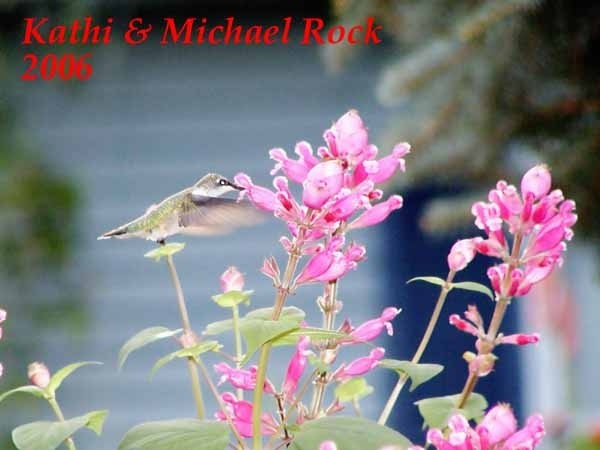
Photo courtesy of the Rock's.
After the Rocks gathered their wealth of information and converted to hummingbird-friendly landscaping, they developed a program called Gardening for Hummingbirds. They began sharing what they had learned through presentations, private consultations with gardeners and free, annual tours of their gardens in mid-September.
"This is when our efforts really took off, because no one else in the states of Wisconsin or Illinois was doing this type of work," Rock says. She adds that "senior citizen groups, gardening clubs, service groups, birding clubs, Wildbirds Unlimited stores and other organizations" began to seek their expertise.
The Rocks have been presenters at the annual Wisconsin Public Television (WPT) Garden Expo for ten years. This led to an interview on WPT.
Rock notes that their speaking engagements have also included master gardener conferences, the Chicago Flower and Garden Show and annual meetings of the Audubon Society.
"We are not ornithologists or master gardeners," Kathi Rock stresses. Yet their intensive effort to educate themselves about hummingbirds and to meet their needs has placed the Rocks in demand. Aside from being tapped for speaking engagements, they are the local go-to experts for people who need help with hummingbird emergencies.
Giving Back to Community
It isn't unusual for the Rocks to receive concerned calls from hummingbird lovers who need help. Around Madison, the Rocks are known as the "Hummingbird People." Sometimes calls concern hummingbirds in dangerous situations, such as one baby bird that most likely fell from a tree and into the narrow well of an automobile windshield wiper.
The car was parked in a home driveway. The owners noticed that an adult hummingbird kept visiting the windshield. They investigated and, after discovering the baby, called a neighbor who knew something about birds.
The neighbor placed a collapsed wire cage against the windshield to protect the baby from predators and vowed to sleep in the driveway until the bird could fledge. She also called Kathi Rock, who immediately brought over a hummingbird feeder to hang near the driveway and helped stand watch.
It wasn't long, Kathi Rock says, before the baby was perching on the wire and the mother was making repeated trips from feeder to windshield to tend to her baby.
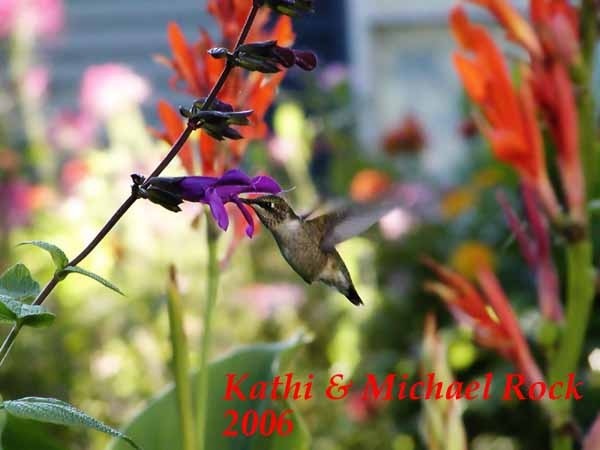
Photo courtesy of the Rock's.
Devoted is a good word for the entire hummingbird community, but it particularly describes the Rocks. Another part of their commitment to protecting hummingbirds and encouraging wildlife gardeners involves publication of their website, Hummingbird Gardening. It contains a gallery of photographs in which hummingbirds are shown nectaring at many kinds of favorite flowers, including more than two dozen Salvias as well as companion plants. For a partial list of the Rock's favorite hummingbird plants, please see the sidebar Planting for Hummers at the end of this article.
Some western species of hummingbirds have made headlines by wandering into the Midwest in recent years, such as Selasphorus rufus -- the feisty, orange-feathered Rufous hummingbird. However, the species that dominates midwestern migration is the Ruby-throated hummingbird (Archilochus colubris). So far, it's the only kind that the Rocks have seen in their gardens.
Holding the annual tour of their home's hummingbird gardens at the end of summer -- the peak of southern Wisconsin's hummingbird season before the Ruby-throats return to Central America -- is another element of the Rocks' devotion to hummingbirds.
Hundreds of people from Wisconsin and northern Illinois attended the tour on two days this past September. The Rocks label all the plants in their gardens so visitors can easily take notes. Admission is free and includes refreshments, an educational presentation, videos and hummingbird-related door prizes purchased by the Rocks or donated by companies such as Wildbirds Unlimited. This year, a hummingbird bander demonstrated the banding process.
When the Rocks talk about giving back to the "community," they don't just mean gardeners in their region. They are part of a large online community of hummingbird lovers of which Flowers by the Sea is also an active participant.
Offering New Salvia Gardeners Tips
We asked the Rocks to share important tips for beginning gardeners interested in growing Salvias and attracting hummingbirds. Here are some of their suggestions:
- Salvias (true sages) are tops for drawing hummingbirds.
- Naturalistic garden designs work well for hummingbirds and sages.
- Start small. Don't try to create a hummingbird landscape in one season. You can begin with container plantings placed near hummingbird feeders.
- Hummingbirds are Western Hemisphere species and respond best to New World native sages. Remember this when purchasing plants.
- Full sun flowerbeds are most attractive to hummingbirds.
- Not all Salvias flower at the same time. Check for bloom seasons when making selections. Especially look for ones that bloom steadily through multiple seasons, such as Anise-Leaf Sages (S. guaranitica spp.) and the many varieties of Tropical Sage (S. coccinea) and Scarlet Sage (S. splendens).
- If you live in a region where hummingbirds depart for their wintering grounds by mid-October, don't rely on late fall bloomers, such as Pineapple Sage (S. elegans).
- To feed hummingbirds and keep your garden colorful, make sure you have something in bloom throughout your entire growing season.
- Include other hummingbird favorites in Salvia beds. Cuphea, Honeysuckle (Lonicera sempervirens) and Catmint (Nepeta) are early and long bloomers.
- Do your homework. Before selecting hummingbird plants, see if their needs match your local growing conditions.
Being Thankful
Right now, most hummingbirds that brighten North American gardens are buzzing around their winter communities far south of the American border. For many gardeners in colder climates, leaf raking and composting may still be underway, but the growing season is at rest. It's a good time to read about hummingbirds (see Attracting Hummingbirds to Your Garden).
It's also a good time for daydreaming about warmer days and designing a wildlife garden that will attract hummingbirds, butterflies, bees and other small creatures. Finally, the season of thankfulness and giving is a good time to appreciate leaders in the field of wildlife gardening, such as the Rocks. We are thankful for being part of their community.
The Rocks may be contacted by email through their website. If you have questions about hummingbird plants grown at our Mendocino Coast farm in Northern California, please don't hesitate to call or send us an email at FBTS. We'll gladly welcome you to our community.
Planting for Hummers
Native plants are attractive to native wildlife. Nature designed both to meet each other's needs. However, supplies of native plants and the timing of their bloom cycle don't always match migration patterns of hummingbirds. Consequently, many hummingbird gardeners mix native and nonnative plants in their gardens.
Kathi Rock says that the philosophy she and her husband follow in making their plant choices primarily is based on what hummingbirds love. She adds that the challenges of their cooler climate and shorter growing season shape decisions and so does the "total absence of Wisconsin native plants that attract hummingbirds and flower in early to mid-fall -- our peak time for hummingbirds."
So the Rocks grow a variety of native and non-native hummingbird plants, including many Salvias (true sages), most of which are annuals in their USDA Zone 5 climate. When selecting nonnative plants, Kathi Rock says they are careful to choose non-invasive species. To maximize hummingbird visits, they recommend posting hummingbird feeders near your Salvia beds.
Here some of their most successful plants with flower colors noted. Please keep in mind that the success of different hummingbird plants may vary by region:
Salvias
- Friendship Sage (S. 'Amistad') purple
- Prairie Sage (S. azurea) blue
- Big Swing Sage (S. x 'Big Swing') blue
- Eyelash Sage (S. blepharophylla) red
- Blue Vine Sage (S. cacaliifolia) blue
- Chiapas Sage (S. chiapensis) pink
- Tropical Sage (S. coccinea) red
- Mexican Sage (S. darcyi) red
- Autumn Sage (S. greggii spp.) many colors
- Anise-Scented Sage (S. guaranitica spp.) blue to purple
- Hot Lips Sage (S. microphylla 'Hot Lips') bicolored red and white
- Mexican Bush Sage (S. leucantha spp.) purples, bicolor purple and white, pink
- Mountain Sage (S. microphylla spp.) reds and pinks
- Royal Purple Autumn Sage (S. muelleri) purple
- Mulberry Jam Roseleaf Sage (S. x 'Mulberry Jam') magenta
- Phyllis' Fancy Sage (S. 'Phyllis Fancy') lavender
- Purple Majesty Sage (S. guaranitica 'Purple Majesty') deep purple
- Giant Brazilian Sage (S. subrotunda) red-orange
- Bog Sage (S. uliginosa) blue
- Waverly Sage (S. x 'Waverly') pale pink to lavender
- Wendy's Wish Sage (S. x 'Wendy's Wish') magenta
Salvia Companions
- Flowering Maple (Abutilon) orange, pink, red and yellow
- Anise Hyssop (Agastache spp.) varying colors, including reds
- Orange Sceptre Butterfly Bush (Buddleia 'Orange Sceptre') orange
- Amber Blush Calamint (Clinopodium coccineum 'Amber Blush') yellow
- David Verity Cigar Plant (Cuphea 'David Verity') orange
- Chilean Glory Flower (Eccremocarpus scaber) orange, pink, red and yellow
- Rose of Sharon (Hibiscus syriacus) pinks, purple, white
- Jewelweed (Impatiens capensis) orange
- Red Morning Glory (Ipomoea coccinea) red
- Pink Hawaiian Pitchersage (Lepechinia hastata) pink
- Cardinalflower (Lobelia cardinalis spp.) red
- Trumpet Vine (Lonicera sempervirens) red
- Jacob Kline Red Beebalm (Monarda didyma 'Jacob Kline') red
- Catmint (Nepeta spp.) lavender
- Flowering Tobacco (Nicotiana mutabilis) white changing to pink
- False Petunia (Ruellia elegans) red
- Argentine Hardy Orange Gloxinia (Sinningia sellovii) red-orange
 Salvia x 'Wendy's Wish'
Salvia x 'Wendy's Wish'  Salvia x 'Waverly'
Salvia x 'Waverly'  Salvia uliginosa
Salvia uliginosa  Salvia splendens 'Giant Form'
Salvia splendens 'Giant Form'  Salvia subrotunda
Salvia subrotunda  Salvia x 'Phyllis' Fancy'
Salvia x 'Phyllis' Fancy'  Salvia x 'Mulberry Jam'
Salvia x 'Mulberry Jam'  Salvia muelleri
Salvia muelleri  Salvia x 'Maraschino'
Salvia x 'Maraschino'  Salvia microphylla 'Flower Child'
Salvia microphylla 'Flower Child'  Salvia leucantha 'Midnight'
Salvia leucantha 'Midnight'  Salvia involucrata 'Hadspen'
Salvia involucrata 'Hadspen'  Salvia microphylla 'Hot Lips'
Salvia microphylla 'Hot Lips'  Salvia guaranitica 'Sapphire Blue'
Salvia guaranitica 'Sapphire Blue'  Salvia greggii 'Orange Yucca Do'
Salvia greggii 'Orange Yucca Do'  Salvia darcyi 'Pscarl'
Salvia darcyi 'Pscarl'  Salvia coccinea 'Forest Fire'
Salvia coccinea 'Forest Fire'  Salvia chiapensis
Salvia chiapensis  Salvia cacaliifolia
Salvia cacaliifolia  Salvia blepharophylla `Diablo'
Salvia blepharophylla `Diablo'  Salvia x 'Big Swing'
Salvia x 'Big Swing'  Salvia azurea
Salvia azurea  Salvia atrocyanea
Salvia atrocyanea  Salvia 'Amistad'
Salvia 'Amistad'  Salvia gachantivana
Salvia gachantivana 
Comments